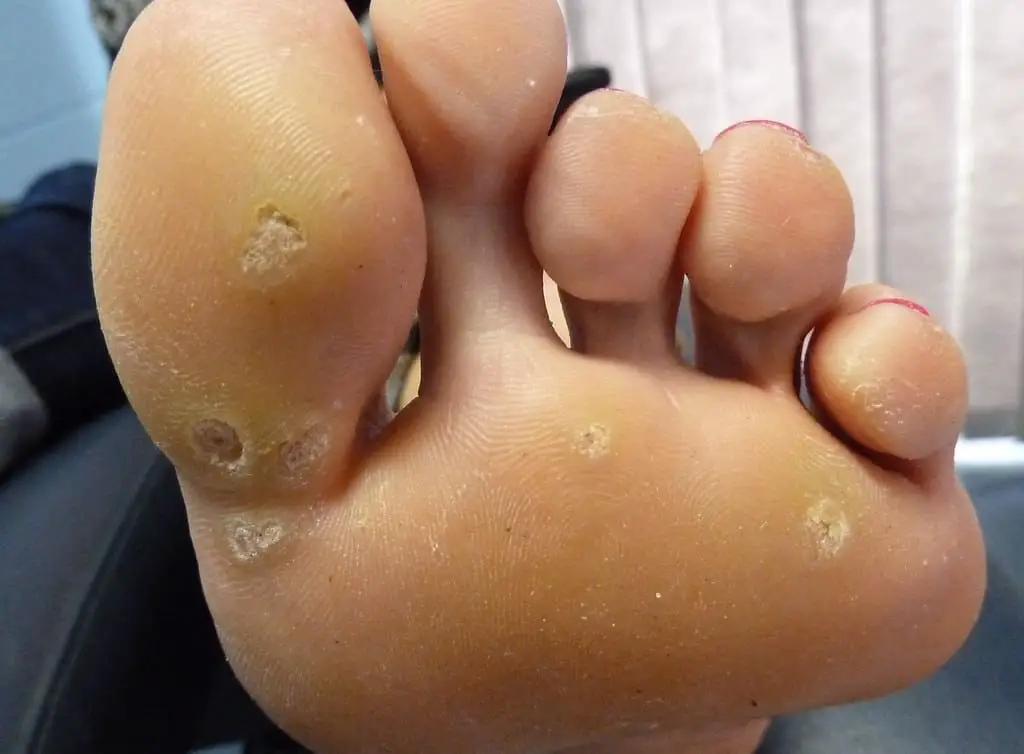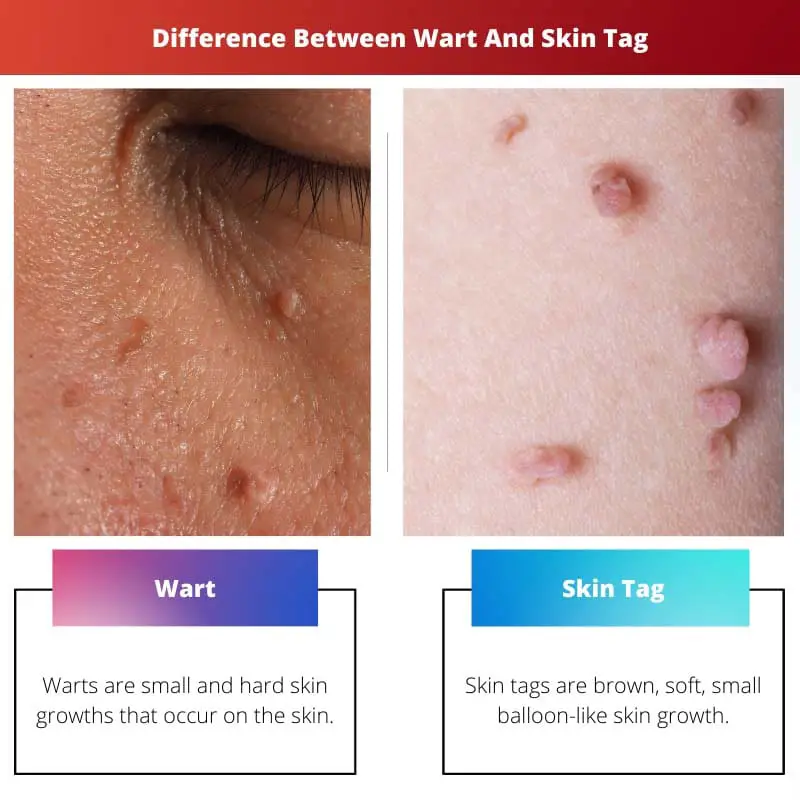Wart and Skin tags are both skin diseases, more types of a virus that affects the skin. Though they are a risk to your health, they make your skin look spotty. Everyone loves their skin and a spot on skin seems very uncomfortable.
Warts and skin tags are not cancerous and so their growth isn’t fatal but they can be painful. There are many differences between warts and skin tags.
Key Takeaways
- Warts are small, rough skin growths caused by the human papillomavirus (HPV), while skin tags are benign, soft, skin-colored growths that hang from the skin’s surface.
- Warts are contagious and can spread through direct contact or shared surfaces, whereas skin tags are not contagious and develop due to skin friction.
- Warts may resolve spontaneously or require treatment, such as cryotherapy or salicylic acid, while skin tags can be removed through surgical methods if desired.
Wart vs Skin Tag
Warts are caused by the human papillomavirus (HPV) and can appear anywhere on the body. They have a rough surface and can be raised or flat. Skin tags are small, soft growths that hang off the skin. They are harmless, but they can be bothersome or unsightly if they are located in a visible area.

Warts make the skin rough and the skin color becomes different mostly white. They appear in areas where the skin is thick. Warts are mostly caused by a virus known as human papillomavirus aka HPV.
The top layers of the skin are affected by this virus resulting in skin growth. Warts can spread to other people.
Skin tags are small bumps that are caused because of the friction of clothes and skin. Skin tags are not contagious but they hurt. They bleed, hurt, and can be itchy too. The small bumps are fleshy and stick out of the skin with a brown or skin color.
Comparison Table
| Parameters of Comparison | Wart | Skin Tag |
|---|---|---|
| What is it? | Warts are small and hard skin growths that occur on the skin. | Skin tags are brown, soft, small balloon-like skin growth. |
| Cause | The cause of warts is a virus known as HPV. | The exact reason is not known but it is considered that friction between clothes and skin causes skin tags. |
| Contagious | Warts are contagious and can spread to other people. | Skin tags are not contagious. |
| Color | Warts look like white spots on the skin. | Skin tags are brown or skin-colored. |
| Treatment | Salicylic acid and cryotherapy are used to treat warts. | Skin tags are removed by cutting them with scissors or freezing them with liquid nitrogen. |
What is Wart?
Warts are skin growths. They are small, hard, and rough. Warts are mostly caused by a virus known as human papillomavirus (HPV). The virus affects the top layers of the skin. HPV virus enters the body from the point where the skin is slightly damaged.
There are about 130 types of known HPV.
Warts are skin growth so there are no symptoms of it. You would notice the, on your skin as spots. Warts can be of small or big size and they can appear in groups or single as well. Warts can be bump or flat, and they can go deep on the skin.
Warts are contagious and they spread to others, therefore, people who are working in meat shops or have a weak immune system. Also, people who use public bathrooms are at risk.
Warts mostly occur on feet and hands. Though they can happen at other body parts too. They are more common in children. There are many types of warts: Flat warts, genital warts, mosaic warts, filiform warts, plantar warts, and periungual warts.
Salicylic acid and cryotherapy are used to treat warts, and it can take a few months to a year-long of time.

What is Skin Tag?
Skin tags are skin growth that occurs mostly in the thick skin areas or areas where skin fold. They can appear at places like armpits, necks, under breasts, groin, etc. Skin tags are small and look like small balloons popping out of the skin.
They are brown or flesh-colored.
The exact reason for the growth of skin tags is not known however it is considered that the friction between clothes and skin can cause them.
Also, some more reasons can be overweight, diabetes, hormonal imbalance, high blood pressure, high cholesterol level, And it can be HPV as well. Some studies have shown that 48% of the skin tags contain a type of HPV.
Skin tags are not contagious but they can be itchy, and painful. However, if the skin tags grow enormously, bleed, and display colors like pink, red and black then they can be harmful and can lead to skin cancer.
And they would require immediate medical attention.
The normal skin tags don’t require any treatment and also they can be persistent once they form. However, sometimes they fall off spontaneously.
And many times they are removed for cosmetic reasons through procedures like cryosurgery, surgical ligation, excision, cauterization, etc.
Main Differences Between Wart And Skin Tag
- Warts are contagious, they can spread to other people while skin tags are not contagious.
- Warts are caused by a virus while Skin tags are caused because of friction between clothes and skin.
- Warts mostly happen to children while skin tags are most common in adults.
- Warts are the same color as skin or look like white spots while skin tags are brown or flesh-colored.
- Warts make the skin rough and hard while skin tags are soft and itchy.
- Warts mostly occur at feet and hands while skin tags occur at armpits, neck base, groin, etc.

The writing was quite comedic. Although the information is based on facts and research, it was presented in a pleasing manner.
I believe that humor detracts from the integrity of the article. It was misleading and inappropriate.
I couldn’t agree more. I found the humorous approach quite refreshing.
The content appears to be correct, errors should be assessed with the utmost precision.
In today’s society, articles of this caliber are hard to come by. Very thought-provoking.
There are apparent inaccuracies here, the sources are clearly unreliable.
The analysis is flawed and unreliable. There is no correlation between the information and the sources.
This content is very sophisticated and accurate. It was a pleasure to read such an articulate text.
The accuracy and reliability of the article should be revered. However, the content is slightly misleading.
There were no errors in the article. It was very well-researched.
There are incongruities in the data. It is evident that the article is not entirely accurate.
This was a very informative article, it provided comprehensive information regarding skin conditions. Very beneficial.